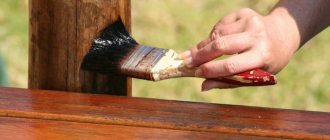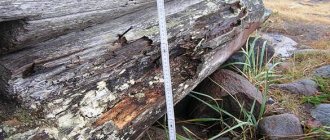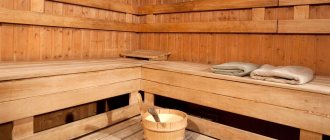Wood is an affordable, environmentally friendly building material with a beautiful appearance. Modern materials (expanded clay concrete, foam concrete) have recently become often used for the construction of walls and partitions, but their popularity in the construction of small houses is still inferior to wood.
However, being an organic material, wood is too hygroscopic and is an excellent breeding ground for mold and microorganisms. Therefore, when using this material, you should pay special attention to its protection from external factors.
Causes of wood rotting
The development of mold fungi is the main factor that destroys wood. Mold development (rotting) occurs under certain conditions:
- air humidity 80–100%;
- material humidity above 15%;
- temperature below 50 and above 0 C0
Additional reasons for rotting may include freezing of the material, stagnation of air, and contact with the soil.
Factors favorable to the decay process are quite common. Therefore, you need to know how to treat wood to protect it from mold.
Drying wood
You should start with preventive measures. To prevent the development of mold, the wood must be dry. There are four methods for drying timber or boards:
- Natural drying in dry rooms with good ventilation. This is the longest method (drying time is up to 1 year).
- Drying in a chamber using superheated steam and hot air. This is a more expensive, but fast and effective method.
- Paraffinization. The tree is immersed in liquid paraffin and placed in an oven for several hours.
- Steaming in linseed oil. Suitable for small wooden products. The tree is immersed in oil and boiled over low heat.
Processing using the Finnish method
For the Finnish method of wood processing, you will need salt, water, iron sulfate, slaked lime, and flour. Mix the ingredients thoroughly until smooth. Most of the mixture should be water and flour.
Heat the mixture over low heat and immediately apply it to the wooden surface. This composition is not washed off with water and stays on the wood for a long time.
The method is safe, but it is recommended to use it for treating barriers and roofing. After the first layer has dried, repeat the treatment. If the composition has cooled down, it must be reheated.
Protecting wooden elements from moisture
Modern waterproofing allows you to protect timber from capillary moisture. A high-quality roof and the application of special paints and coatings protect the structure from atmospheric moisture.
Protection against condensation accumulation is provided by thermal and vapor barrier. The heat-insulating layer is placed closer to the outer surface, and a vapor barrier is placed between it and the wooden wall. The timber of the roofing elements is protected from rain and snow by waterproofing films.
Wooden houses and structures must be located above ground level, on a foundation. For effective protection from water, it is worth taking care of the presence of a blind area and an effective drainage system. Of great importance for the biostability of a wooden building is the possibility of natural drying of the walls. Therefore, trees should not be planted near wooden buildings.
Impregnation selection criteria
Which wood preservative is best to choose depends on four criteria:
- environmental friendliness and harmlessness;
- purpose;
- composition;
- prices and efficiency of use.
Ecological cleanliness
Health safety becomes most important when treating areas where children are present. And in this case, the environmental friendliness of impregnation comes first among other factors.
Purpose
Based on the goals that need to be achieved when treating the surface, impregnations are divided according to their purpose.
For example, impregnation for boards against moisture and rotting, which of them is better indicated below, should protect the wood from fungi, mold and exposure to water. They are used in rooms with high humidity, such as baths or saunas.
There are also compositions that resist temperature changes well - frost-resistant. The addition of components that prevent combustion produces fire-retardant impregnations.
The introduction of pigments into the composition makes it possible to obtain decorative impregnations.
Impregnation of a log house with brown color Source www.s-stroy39.ru
Impregnations may also contain special UV filters and components that resist atmospheric influences. Most modern formulations have a combination of the listed qualities.
Compound
Experts advise giving priority to aqueous formulations. They are the most versatile, environmentally friendly, applied manually and mechanically.
When considering antiseptics, you should not ignore acrylic preparations. They have excellent water resistance and are reasonably priced
However, they have one drawback - the inability to work at low temperatures.
Acrylic-based impregnationSource kraski-kapitel.ru
There is one more component on the basis of which wood impregnations are produced - these are organic solvents
Such compositions have excellent protective properties, but caution should be exercised when using them due to the toxicity of many compositions
When choosing which antiseptic for wood is better to choose, you can immediately select the appropriate color of the composition, since the impregnation can also have decorative functions and change the shade of the wood.
Consumption
When deciding which wood preservative is best, you should not lose sight of such an important indicator as material consumption
This is a common mistake of many - paying attention to the price and not taking into account the consumption. A high-quality composition provides reliable protection after applying a couple of layers, while cheaper ones require multi-layer coatings
As a result, purchasing high-quality compounds is more profitable than their cheap counterparts
A high-quality composition provides reliable protection after applying a couple of layers, while cheaper ones require multi-layer coatings. As a result, purchasing high-quality compounds is more profitable than their cheap counterparts.
Application of impregnation Source tovarim.ruWhat to do if the timber begins to rot
Rotting greatly deteriorates the physical parameters of the tree. Its density drops by 2–3 times and its strength by 20–30 times. It is impossible to restore a rotten tree. Therefore, the element affected by rot should be replaced.
If the mold infestation is minor, you can try to stop the process. To do this, the rotten area is completely removed (including part of the healthy wood). The removed part is replaced with steel reinforcing rods, which must go deep enough into the healthy part of the element. After reinforcement, the area is puttied with epoxy or acrylic putty.
This is a labor-intensive and complex procedure, after which it is not always possible to achieve the previous strength of the structure. The problem is easier to prevent by treating the wood to prevent rotting.
Why is antiseptic tinting necessary?
Impregnations can be colorless or colored. If you need to give a tint to the wood and emphasize its texture, then select a tint antiseptic. You can also add color to a colorless antiseptic. To do this, do the tinting of wood antiseptic with your own hands - a special tint dye is added to the colorless solution.
Tinting should be done to protect the color of the natural material from fading. In addition, different shades give the building a noble appearance and make the exterior decoration more harmonious. After applying tint solutions, ordinary pine or alder is transformed in appearance: a beautiful shine appears, the texture of the wood is clearly visible.
Advice! If the question arises : how to wash your hands from wood antiseptic, then in this case a special product can help out - hand cleaning paste. It is often sold in car dealerships and is good at cleaning dust, dirt, and fuel residues on your hands.
Antiseptics help extend the life of wooden products. You can buy them, but it’s easier and cheaper to make them yourself. You will need the simplest ingredients and a minimum of time to prepare an effective impregnation, which in properties is not inferior to factory-made analogues.
Protecting a tree with folk remedies
The problem of protection against rotting has been relevant since the time when wood was first used as a material. Over the course of a long time, many effective folk recipes have accumulated that are still successfully used today:
- Coating wooden structures with silicate glue.
- Treatment of walls and soil (up to 50 cm depth) with a solution of potassium dichromate in sulfuric acid. 5% solutions of acid and potassium dichromate are mixed 1:1.
- Treatment with vinegar and soda. The affected areas are sprinkled with baking soda and sprayed with vinegar from a spray bottle.
- Treating wood with a 1% solution of copper sulfate.
- Hot resin impregnation. A very effective method for treating logs, fence stakes, benches in contact with the soil.
- Using salt with boric acid. A mixture of 50 g of boric acid and 1 kg of salt per liter of water should be treated several times, at intervals of 2 hours.
All these methods are only suitable for healthy wood or when the tree has small lesions.
Conclusion
To preserve the presentable appearance of the facade or decoration and prevent harmful effects, specialized protective equipment is used. They will not only emphasize the beauty of the tree, but will also help extend its service life, and timely renewal of coatings will postpone the need for replacement or reconstruction for many years.
Not only the original wooden walls need protection, but also any wood facing materials, for example, imitation timber or shingles. In the video there is a master class: a wooden sofa for the garden.
Subscribe to our Telegram channelExclusive posts every week
Modern methods of combating rotting
There are two ways to reliably protect wood: conservation and antiseptic treatment.
When preserving, a product with a long-lasting toxic effect is applied to the timber or board. To do this, the wood is soaked in cold or hot baths, or the preservative penetrates into it using diffusion or autoclave impregnation. The method is applicable only in factory conditions.
Antiseptic treatment involves self-impregnation of the material by applying chemicals with a spray bottle or roller. The antiseptic agent must be selected in accordance with the operating conditions of the wooden structure. For example, impregnations based on water and white spirit are safe and inexpensive, but are easily washed off. Therefore, only water-repellent antiseptics are suitable for elements in contact with moisture or soil.
Classification of antiseptics
When choosing a product to treat timber, it is worth understanding the main categories and types of protective compounds. There are three categories of compositions for protecting wood: paints, varnishes, and antiseptics.
Paints perform both protective and aesthetic functions. For interior work it is better to choose water-soluble paints, and for exterior paints - based on an organic solvent.
Varnishes form a protective film on the surface without changing its appearance. For exterior work, varnishes with fungicides are used that kill mold and prevent cracking and fading of wood.
Antiseptics work great when mold has already infected the tree. There are 5 types of them:
- Water soluble. Odorless, non-toxic, dry quickly. They are made on the basis of fluorides, silicofluorides, a mixture of boric acid, borax or zinc chloride. Not recommended for treating surfaces frequently in contact with moisture.
- Water repellent. They are distinguished by deeper penetration into the tree. Suitable for processing bath structures, cellars and basements.
- On organic solvents. Allowed for use in external and internal work. Forms a thick film that dries up to 12 hours.
- Oily. They form a thick, durable coating that is insoluble in water. However, they should only be used with dry wood. When applied to damp wood, oil antiseptics do not prevent the proliferation of fungal spores inside the material.
- Combined. Suitable for any wood and additionally have anti-flammable properties.
We increase fire resistance
Protecting wood from moisture and rot is not the entire range of work that must be performed before use. One of the weak points of wooden structures is their rapid flammability. Therefore, we pay attention to solutions that can slightly increase the degree of fire resistance of wood, the so-called fire retardants. This is especially true in residential buildings.
The essence of fire retardants is that under the influence of high temperature they form a film that can delay the ignition of wood material for some time.
With the help of additional treatments against the influence of all negative factors, the reliability of a wooden structure can be significantly increased. The best treatment is up to consumers to decide depending on individual preferences and conditions.
How to protect wood from moisture (2 videos)
Different types of protective equipment (26 photos)
How to apply a protective coating to wood
Applying antiseptics, varnishes and paints is not difficult. However, carrying out such work requires compliance with certain rules.
- Before handling, wear gloves, a protective mask and goggles.
- Clean the surface to be painted from dirt, grease and old paint with a scraper.
- Clean the board or beam with an old brush or sandpaper.
- Wash the surface with water and detergent.
- Wait until the wood is completely dry.
- Read the instructions for instructions on how to apply the product.
- Start processing wooden structures from the ends, cuts, and damaged areas.
- If it is necessary to apply several layers of coating, you should pause 2-3 hours between applying each layer.
Softwood resins
You can treat the boards using coniferous resins, which are popularly called resin, as it prevents pathogens from penetrating the wood. Also, the natural substance is characterized by bactericidal and antiseptic properties. Time-tested method. Our ancestors treated wood with this miraculous substance.
The leading positions in popularity are occupied by cedar resin, pine, spruce, larch, and fir resin. But the downsides are the pungent odor and stickiness. You cannot apply varnish, paint, or sand the wood on top.
The ideal option would be to apply this composition to underground parts of structures.
Preparing the impregnation
What you need to know about mold protection
The protective composition should be selected based on the operating characteristics of the surface being protected. Only hard-to-wash coatings are suitable for outdoor use. Such products will reliably protect wood for 30 years.
For wet rooms (basements, baths) special products are needed that can withstand sudden temperature changes.
Changes in the color of the wood, the appearance of chips and cracks are a signal that the protective coating should be urgently renewed. It is recommended to alternate antiseptic compounds without treating the wood with the same compound again.
Recommendations for application
Before protecting wood from moisture and rotting outdoors, it is important to study the recommendations for applying protective compounds. Compliance with the rules below will significantly improve the results of the work done:
If the wood is re-treated, the old layer should be carefully removed before applying the composition.
Depending on the condition of the surface layer of the wood, you can use a solvent, scraper or sandpaper. If work is carried out outdoors, it is important to monitor the temperature. The optimal range is from + 18 to + 25 degrees. If it is necessary to apply an additional layer of protective composition, this should be done no earlier than 3 to 5 hours after the first stage of work. It is recommended to apply a second layer of the composition to cracks and cuts, if any. Before treating wood from rotting and moisture, you need to thoroughly dry the material, preferably in the open air.
Before carrying out work, it is important to follow safety rules, namely, put on a respirator and gloves. Contact with skin and inhalation of vapors of protective compounds can cause serious harm to health.
Before work, be sure to wear gloves and a respiratorSource coffeesummit.org











